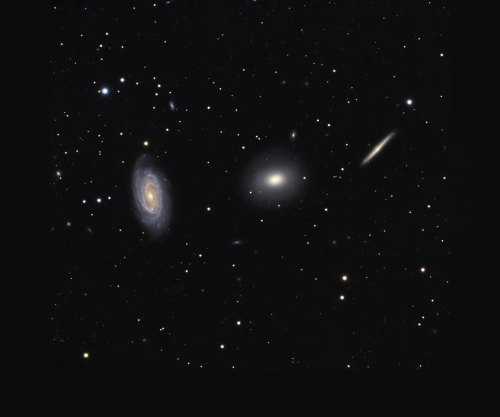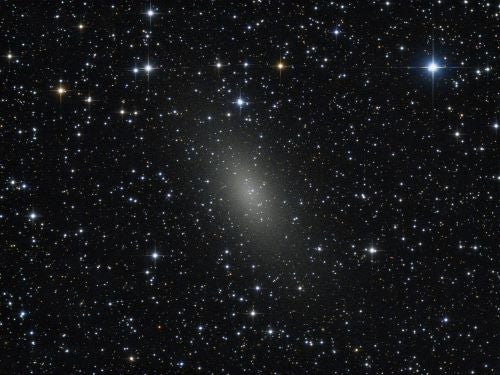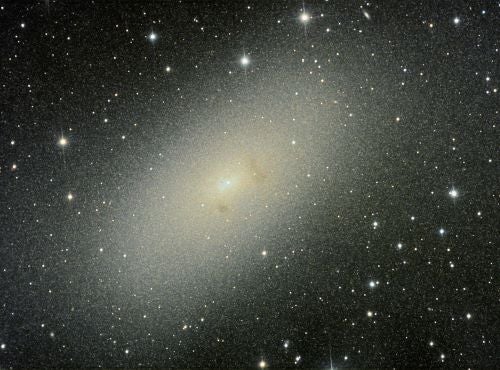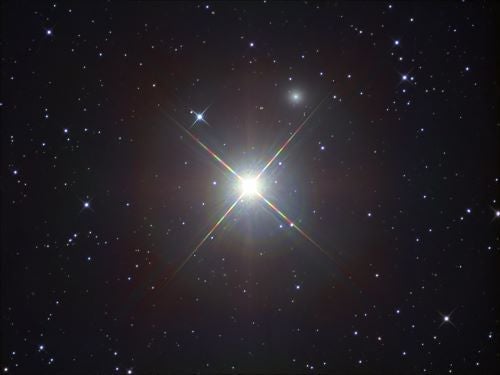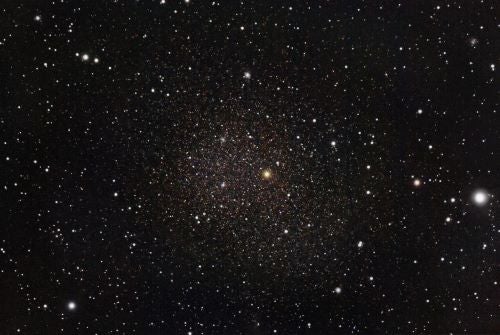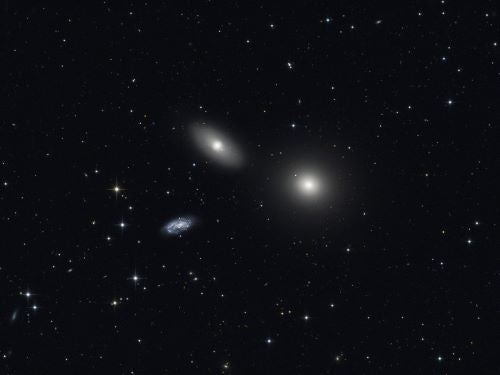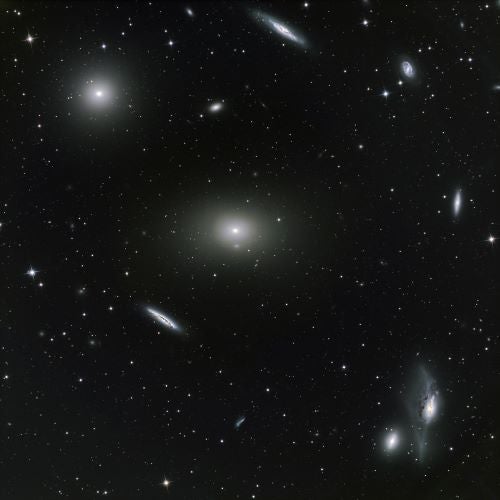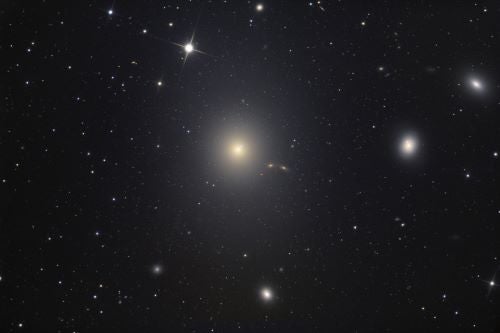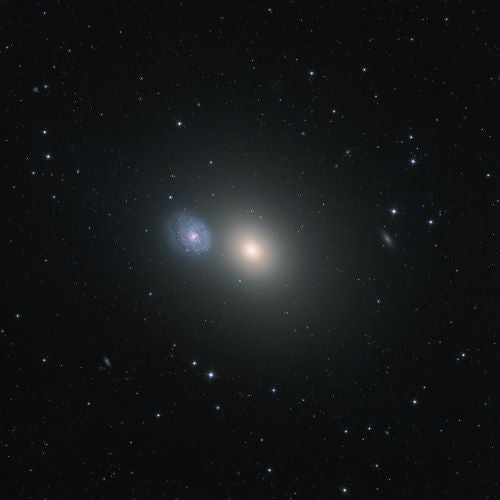To help you with that goal, I’ve selected 22 of these seldom-observed objects visible during fall and spring evenings from northern latitudes. The winter and summer skies contain few ellipticals because of the presence of the Milky Way, which effectively blocks our view of any that lie behind it. I’ve listed them in order of their right ascensions, so those appearing later in the story also rise later at night.
In the fall
The first object on our list, NGC 147 in Cassiopeia, is a satellite galaxy of the Andromeda Galaxy (M31), but not one of the two bright ones nearest it. To find NGC 147, move 1.9° west from magnitude 4.5 Omicron (ο) Cassiopeiae.
Look carefully for this challenging object. At magnitude 9.5, it seems bright for a galaxy, but that light is spread over an area 15′ by 9.4′. NGC 147 is a dwarf elliptical without much apparent structure. When you do see it, you’ll notice an oval halo a bit brighter than the background glow. The galaxy is ever-so-slightly brighter toward the center, so that isn’t a foreground star.
Not quite 1° east of NGC 147, you’ll find magnitude 9.2 NGC 185, which is a dwarf spheroidal galaxy. It touts a higher surface brightness than its companion, although it’s a bit larger, measuring 14′ by 12′. A 12-inch telescope reveals an oval halo with a bright core that spans two-thirds of the galaxy’s diameter.
M32 lies 0.4° due south of the heart of M31. It also glows at magnitude 8.1 and spans 11′ by 7.3′. I’ll forgive you if you choose not to spend too much time observing this pair. After all, M31 is hard to beat.
Now head south from NGC 404 to magnitude 10.5 NGC 584, a fat, lens-shaped galaxy in Cetus. You’ll find it 2.2° northeast of magnitude 3.6 Theta (θ) Ceti. Through an 8-inch scope, you’ll see the broad, bright core taking up three-quarters of the galaxy’s length. A bright halo lies outside the core, but it quickly fades to the black of space. NGC 584 measures 4.1′ by 2′.
Although the dwarf’s magnitude of 8.1 indicates a bright object, its size (12′ by 10.2′) is such that it covers 17 percent of the area of the Full Moon. Its surface brightness, therefore, is low. Through an 8-inch scope, use an eyepiece that yields a 1° field of view, and slowly sweep the area. What you’re looking for is a faint haze just brighter than the background sky.
Our next target is a pair of ellipticals in Eridanus: magnitude 9.8 NGC 1407 and magnitude 10.9 NGC 1400, which lies about 12′ to the southwest of its partner. A magnification of 100x through an 8-inch telescope will show both objects well. No matter the size of your instrument, you will not see details other than a thin halo around the brighter galaxy. NGC 1407 lies 1.5° southeast of the magnitude 5.2 star 20 Eridani.
In the spring
A new season brings a galaxy that travels in elite company. M105 lies only 0.8° north-northeast of the great spiral M96 in Leo. Beyond that, this magnitude 9.3 doesn’t offer observers much in the way of detail. The galaxy has a bright central region surrounded by a halo with an edge that’s difficult to define. Although M105 appears circular at low magnifications, crank up the power past 250x and you’ll see that it’s a fat oval about 4′ across, orienting northeast to southwest.
If you’ve located M105, you probably have seen magnitude 9.9 NGC 3384, which sits a mere 7′ to its east-northeast. Through any size telescope, you’ll see NGC 3384 as an oval twice as long as it is wide (5.4′ by 2.7′) oriented northeast-southwest. The central region is large and bright, and the outer halo appears faint even through large scopes.
For our next elliptical, magnitude 9.7 NGC 4125, head north from Leo to Draco. NGC 4125 forms an equilateral triangle (extending northward) with the top stars in the bowl of the Big Dipper, Dubhe and Megrez (Alpha [α] and Delta [δ] Ursae Majoris, respectively). The galaxy lies 8° from each of those bright stars. Through an 8-inch scope, you’ll see a bright, broadly concentrated oval core with a surrounding haze measuring 6.1′ by 5.1′. Larger apertures extend the length of the elliptical galaxy, and some observers have even noted a nearly stellar nucleus.
Staying in Virgo, we can find another of Messier’s ellipticals, M49, which glows at magnitude 8.4 and measures 8.1′ by 7.1′. Its oval shape is easy to see. The core occupies the central two-thirds of this object, and a fainter outer region envelops it. Because this galaxy is relatively bright, you can crank up the power and reveal this outer halo.
Visually, however, you could do better. Through any telescope up to 20 inches in aperture, M87 appears circular, about 7′ across. Its core stands out as bright, and it spans about one-third of the galaxy’s overall size. To see the famous jet emanating from M87’s nucleus, you’ll have to use a 30-inch or larger telescope under a pristine sky.
Two more Messier objects in Virgo, M89 and M59, follow. They glow at magnitudes 9.8 and 9.6, respectively. M59 is slightly larger, measuring 4.6′ by 3.6′, compared with M89’s 3.4′ diameter. Through large amateur telescopes, M89’s outer regions form a faint ring that fades rapidly with increasing distance from its center. M59 shows an oval glow and uniform illumination that only begins to diminish close to the galaxy’s edge.
At magnitude 9.2, NGC 4697 in Virgo ranks as one of the sky’s brightest galaxies. A small telescope will reveal its hazy nature and oblong shape (7.2′ by 4.7′). Step up to an 11-inch scope, and you’ll see much more detail. Regions outside this galaxy’s core show a threefold variance in brightness, getting fainter as you move farther away. The shape of the bright central region may remind you of a spiral galaxy. In fact, astronomers categorize NGC 4697 as a lenticular galaxy — one with characteristics of both an elliptical and a spiral.
You’ll find the Ursa Minor Dwarf (UGC 9749) in the southernmost part of the northernmost constellation. It lies 4.7° south-southwest of magnitude 3.0 Pherkad (Gamma [γ] Ursae Minoris). To view this satellite of the Milky Way, use at least an 11-inch telescope, but don’t crank up the power.
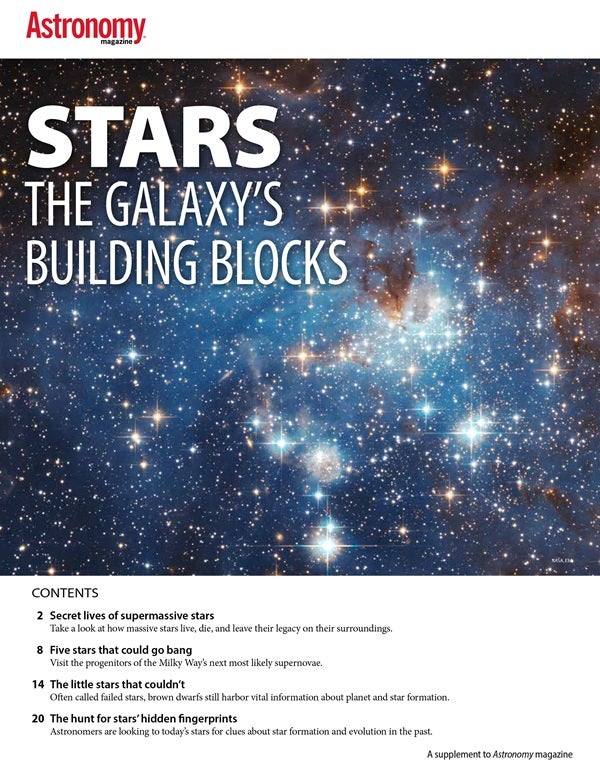
What we can learn from the life cycles of stars? Astronomy’s free downloadable eBook, Stars: The galaxy’s building blocks contains everything you need to know about how stars live, die, and change their galactic homes over time.
The best approach for viewing this object is to head to the darkest observing site you can get to. Then, disengage your telescope’s drive and slowly sweep the dwarf’s region of sky. What you’re looking for is an ever-so-slight increase in the background glow of your eyepiece’s field of view.
Our final target, the magnitude 12.0 elliptical NGC 5982, teams up with two spirals — magnitude 11.1 NGC 5985 and magnitude 13.2 NGC 5981 — for one remarkable view. These three objects lie in Draco in an east-west line less than 14′ long. You’ll find them 1.8° east-northeast of magnitude 3.3 Iota (ι) Draconis.
NGC 5982 is round, small (3′ across), and featureless. NGC 5985, meanwhile, sports faint spiral arms, though you’ll need at least a 12-inch telescope to spot any detail. NGC 5981 is another of the universe’s “needle” galaxies: Thanks to its edge-on orientation, it simply looks like a white line. To see this trio, use a magnification around 100x.
Go observe them
As this list shows, elliptical galaxies can offer observers of all experience levels a wide variety of objects. Just set up at a dark site, take your time viewing each object, and try a variety of eyepieces. Oh, and have fun!

